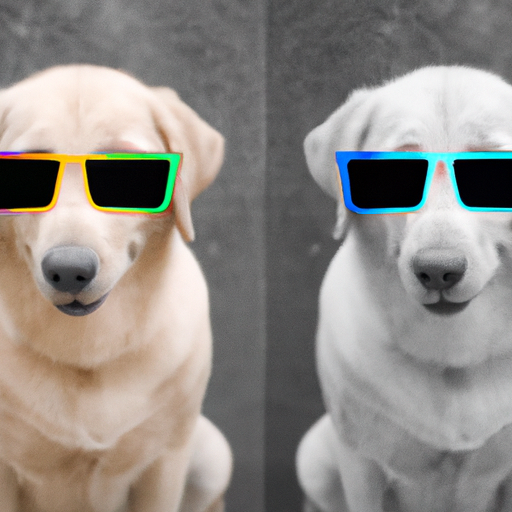If you’ve ever wondered whether your furry friend sees the world in the same way you do, you’re not alone. The question of canine color vision has been a topic of curiosity among pet owners and scientists alike for years.
Dogs, as it turns out, are colorblind – but not in the way you might think. They don’t see the world in black and white, but rather in a spectrum of colors that is much more limited than what human eyes perceive.
In this article, we’ll delve into the science behind dog color vision, exploring what colors dogs can see, how their vision differs from ours, and what this means for your relationship with your furry friend.
Table of Contents
- The Science Behind Canine Color Vision
- The Colors Dogs Can See
- How Dog Vision Differs From Human Vision
- What This Means for Dog Owners
- Frequently Asked Questions
Key Takeaways
- Dogs see the world in a spectrum of blues and yellows, not in black and white.
- Their vision is not as vibrant as ours, but they have other sensory advantages.
- Understand a dog’s vision can help improve their training and overall well-being.
The Science Behind Canine Color Vision
Dogs are dichromats, meaning they have two types of color receptors in their eyes. This is different from humans, who are trichromats and have three types of color receptors. This dichromatic vision allows dogs to see colors, but not in the same way that we do.
According to a study conducted by the University of California, Santa Barbara, dogs see the world primarily in blues and yellows. They cannot distinguish between red and green, similar to a human with red-green color blindness.
The Colors Dogs Can See
As we’ve established, dogs see the world in a different color spectrum than humans. They can see shades of blue and yellow, but other colors like red, orange, green, and purple likely appear as different shades of blue and yellow.
The table below provides a rough comparison of how dogs might perceive various colors compared to humans:
| Human Perception | Dog Perception |
|---|---|
| Red | Dark Blue |
| Orange | Light Blue |
| Yellow | Light Yellow |
| Green | Gray |
| Blue | Dark Blue |
| Purple | Light Blue |
How Dog Vision Differs From Human Vision
While dogs may not see the world in as many colors as we do, they have other visual advantages. For example, dogs are much better at seeing in the dark and detecting movement than humans are.
This is due to the higher number of rods in their eyes, which are the light-sensitive cells responsible for detecting motion and seeing in low-light conditions. This enhanced ability to see in the dark and perceive movement is a vestige of their wild ancestors, who relied on these skills for hunting and survival. You can learn more about this on OneTopDog.
What This Means for Dog Owners
Understanding your dog’s vision can help you provide a better environment for them. For example, choosing toys and accessories in colors they can see (like blue and yellow) can make playtime more enjoyable for them.
Furthermore, knowing that your dog has excellent night vision and motion detection can help you understand their behavior. If your dog seems particularly alert or anxious at night, it might be because they’re picking up on movements or sights that you can’t see.
For more tips on how to cater to your dog’s visual capabilities, check out this guide on OneTopDog.
Frequently Asked Questions
Q: Do dogs see in black and white?
A: No, dogs see in shades of blue and yellow. They cannot distinguish between red and green.
Q: Can dogs see in the dark?
A: Yes, dogs have excellent night vision due to the high number of rods in their eyes.
Q: How can I make my home more visually appealing to my dog?
A: Choose toys and accessories in colors that dogs can see, like blue and yellow. Also, consider that dogs have excellent motion detection, so toys that move could be particularly engaging for them.
Q: How does a dog’s vision compare to a human’s?
A: Dogs see fewer colors than humans, but they have better night vision and motion detection.
In conclusion, while dogs may not see the world in the vibrant array of colors we do, they have their own unique visual strengths. By understanding these, we can better cater to their needs, enrich their lives, and deepen our bond with them. For more insights on dogs and how they perceive the world, visit OneTopDog.



